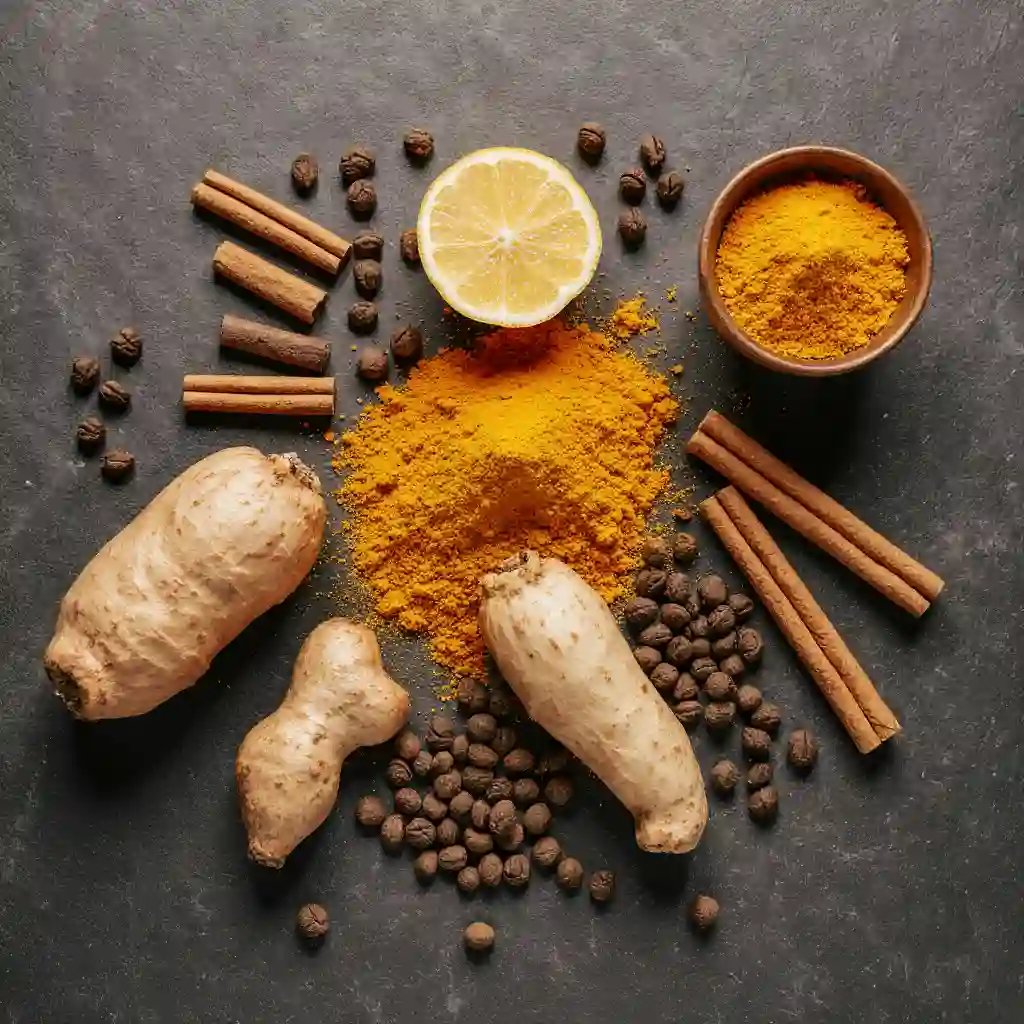Herbs & spices have shaped my cooking journey from the start. I still remember the scent of dried mint and toasted cumin drifting through my grandmother’s kitchen—it was her language of love. She never measured, never rushed, but each dish came alive with just a few well-chosen sprinkles. That early exposure taught me that herbs & spices do more than flavor our meals—they connect us to culture, wellness, and tradition.
Whether you’re grinding black pepper or tossing in fresh basil, you’re not just seasoning food—you’re participating in something ancient and meaningful. In this article, we’ll explore what makes herbs & spices so essential: their definitions, global history, health benefits, and everyday uses in home cooking. Let’s open your spice drawer and get started.
In this article, we’ll explore how herbs and spices have shaped the world—from trade routes and traditional healing to their place in modern kitchens. You’ll learn their culinary value, health perks, and even how to store them for maximum punch. Let’s open the jars and dive into the story they tell.
What Are Herbs & Spices? Understanding the Basics
Defining Herbs vs. Spices
At first glance, herbs and spices seem interchangeable. But botanically and practically, they’re quite different. Herbs come from the green, leafy parts of a plant—think basil, parsley, mint. Spices, on the other hand, are typically derived from other plant parts like seeds (coriander), roots (ginger), bark (cinnamon), or berries (black pepper).
The distinction matters not just for identification, but also for understanding how their flavors behave in cooking. For example, delicate herbs often get added at the end of cooking, while robust spices like cloves or cardamom can simmer for hours without losing their essence.
Their origins reflect this diversity. While herbs grow well in temperate climates, spices often thrive in tropical zones. That’s why regions like India, Indonesia, and Sri Lanka have been centers for spice cultivation for thousands of years.
A Global A–Z Overview
It’s hard to pick favorites with so many herbs and spices available, but here’s a quick tour of well-loved and lesser-known varieties:
- Basil – A staple in Italian cuisine, it’s sweet and peppery, perfect for tomato dishes and fresh salads.
- Saffron – Derived from the stigmas of the crocus flower, this golden spice adds color and aroma to rice dishes like paella and biryani.
- Za’atar – A Middle Eastern blend often combining thyme, oregano, sumac, and sesame seeds. Delicious on flatbreads or vegetables.
- Coriander – While the leaves (cilantro) are a herb, the seeds are a spice, offering a citrusy, earthy flavor.
- Sumac – Tangy and vibrant, it brings brightness to meats, salads, and dips.
This alphabet of global ingredients shows how herbs and spices serve not just as flavor agents, but as cultural symbols passed down through generations.

The Journey of Herbs & Spices Through History
Ancient Trade Routes & Cultural Exchange
Long before they lived in your kitchen drawer, herbs and spices shaped economies, fueled exploration, and even sparked wars. Civilizations like the Egyptians, Greeks, and Romans treasured spices not just for taste but for their ritual and medicinal properties. Frankincense and myrrh weren’t just biblical gifts—they were part of an early global trade system.
The famed Spice Road, a network of land and sea routes, connected Asia, the Middle East, and Europe. Indian black pepper was known as “black gold,” while cinnamon from Sri Lanka was transported over thousands of miles to Roman feasts. Arab traders guarded their sources closely, even spinning tales about giant birds and deadly snakes to keep others away.
During the medieval period, European demand surged. Nutmeg and cloves were worth more than gold by weight, prompting voyages that changed the world—including Columbus’s mistaken trip west in search of spice-rich India. These trades didn’t just bring flavor—they carried knowledge, tradition, and culture with every shipment.
From Medicine to Modern Medicine Cabinet
Historically, herbs and spices weren’t just kitchen essentials—they were cornerstones of ancient medicine. Turmeric, for example, has been used in Ayurvedic and Chinese traditions for its anti-inflammatory qualities. Garlic was prized in Greek temples and Roman armies for stamina and healing. And ginger? A trusted remedy for nausea for over 2,000 years.
What’s remarkable is how modern science is validating many of these ancient claims. Studies show that curcumin, the active compound in turmeric, has powerful anti-inflammatory effects. Gingerol in ginger supports digestion and reduces oxidative stress. Even cinnamon may help regulate blood sugar levels.
If you’re curious how to use spices like turmeric effectively, check out this simple guide on turmeric for inflammation for real-world applications.
Though not all old-world remedies hold up under clinical scrutiny, the majority of culinary herbs and spices continue to bridge the gap between tradition and modern wellness. Their story is still unfolding, one pinch at a time.
Flavorful Uses in Cooking: Kitchen Staples & Global Blends
Culinary Must-Haves by Cuisine
Every cuisine has its signature palette, and herbs and spices are the brushstrokes that bring flavor to life. From the earthy warmth of cumin in Mexican dishes to the fragrant complexity of garam masala in Indian cooking, these ingredients define the soul of a region’s food.
Here’s a look at what makes up the backbone of some beloved global flavors:
- Moroccan: Cumin, coriander, cinnamon, turmeric, paprika, and saffron work together in savory stews like tagine.
- Indian: Turmeric, cumin, cardamom, mustard seed, fennel, and fenugreek blend to create deeply layered curries and dals.
- East-Asian: Ginger, garlic, green onion, Sichuan peppercorns, and star anise are essential to many Chinese and Korean dishes.
- Mexican: Oregano, cinnamon, bay leaf, and chili powders define everything from mole sauces to adobos.
Even in simple dishes, the right spice combination can transport you across borders. A pinch of ground coriander or a handful of chopped parsley makes the difference between a good meal and a memorable one.
Popular Spice Mixes Worldwide
One of the most efficient ways to explore global cooking is through spice blends. These mixes, often regional or family-specific, offer balanced profiles that tell a story with each bite:
- Garam Masala (India): A warm, toasty blend of cardamom, cloves, cinnamon, cumin, and pepper—perfect in curries or lentil soups.
- Za’atar (Middle East): A tangy, nutty herb mix featuring thyme, sumac, and sesame—excellent on roasted vegetables or flatbread.
- Berbere (Ethiopia): A bold, spicy blend with paprika, fenugreek, ginger, and chili—central to dishes like doro wat.
- Chinese Five-Spice: A sweet-savory mix of star anise, clove, cinnamon, Sichuan pepper, and fennel—great with duck or tofu.
- Ras el Hanout (North Africa): A complex, sometimes 12+ spice mix with cardamom, mace, rose petals, turmeric—ideal in couscous or slow-cooked lamb.
By using these traditional blends, even basic recipes can gain an authentic twist. It’s an effortless way to honor culinary heritage while expanding your flavor comfort zone.
Health Benefits of Herbs & Spices
Antioxidant & Anti-Inflammatory Power
Behind every herb and spice is a powerhouse of active compounds that do more than just flavor your food. Many are rich in polyphenols, flavonoids, and essential oils that help your body combat oxidative stress and chronic inflammation—two key drivers of aging and disease.
Take turmeric. Its active compound, curcumin, has been studied extensively for its anti-inflammatory properties. But on its own, curcumin isn’t well absorbed. Enter black pepper. Its piperine compound increases curcumin absorption by up to 2,000%, making turmeric and black pepper a team with real nutritional impact.
Other superstars include:
- Gingerol in ginger: eases nausea, supports immunity.
- Cinnamaldehyde in cinnamon: shown to improve blood sugar response.
- Thymol in thyme and oregano: offers antimicrobial and antioxidant effects.
While these benefits aren’t magic bullets, they’re valuable daily allies—especially when used in whole food form rather than supplements.
Heart, Gut, Brain & Beyond
The perks of herbs and spices go beyond antioxidants. They also support core body systems in meaningful ways:
- Heart: Garlic and cinnamon may help lower cholesterol and support blood pressure control.
- Gut: Fennel, ginger, and peppermint ease digestion and reduce bloating.
- Brain: Sage and turmeric show potential in supporting memory and cognitive function.
- Immunity: Oregano and thyme are known for their antimicrobial properties.
If you’re interested in culinary ways to tap into these effects, this guide to using turmeric for inflammation is a great place to start.
These small ingredients pack a big punch when added to everyday cooking—not as trends, but as time-tested tools for wellness.
FAQs: People Also Ask
What’s the difference between a herb and a spice?
Herbs come from the soft, green, leafy parts of plants (like parsley or mint), while spices come from seeds, bark, roots, or fruits (like cinnamon or cloves).
Which herbs & spices are best for reducing inflammation?
Turmeric (with black pepper), ginger, cinnamon, garlic, and oregano are among the most researched for anti-inflammatory effects.
How should I store dried spices to maintain their flavor?
Keep them in airtight containers away from light, heat, and moisture. Avoid storing above the stove where heat degrades potency.
What are essential spices for Moroccan or Indian cuisine?
For Moroccan: cumin, cinnamon, turmeric, paprika, saffron.
For Indian: turmeric, cumin, cardamom, fenugreek, coriander, mustard seed.
Can spices interact with medications?
Yes. For example, turmeric can affect blood-thinning medications. Always consult your doctor before consuming large amounts or supplements.
Final Thoughts
Herbs and spices aren’t just flavor enhancers—they’re fragments of history, drops of wellness, and anchors of culture. With every sprinkle, you’re adding depth to your food and often giving your health a gentle boost.
So go ahead—experiment, taste, and explore. Let your kitchen be a space where tradition meets curiosity.
Try one new spice blend this week and share your favorite recipe with us—because flavor, after all, is meant to be shared.
⚠️ Disclaimer
If pregnant, nursing, taking medications, or managing health conditions, consult your healthcare provider before high-dose spice use or supplements.






3 thoughts on “Herbs & Spices: Discover Flavor, Health, and Rituals in Every Sprinkle”